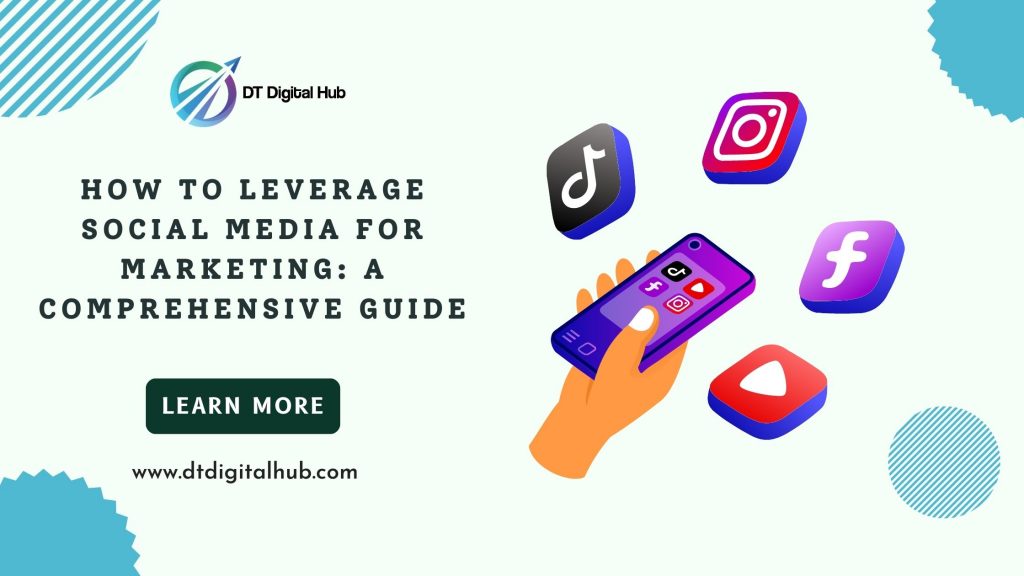Introduction
In today’s digital age, social media has become an integral part of our daily lives. Millions of people worldwide use platforms like Facebook, Twitter, Instagram, LinkedIn, and others to connect with friends, family, and brands they love. As a savvy marketer, tapping into the power of social media can significantly impact your business’s success.
Social media marketing allows you to reach a massive audience, engage with potential customers, and build a loyal following for your brand. However, to succeed in the competitive social media landscape, you need a well-crafted strategy and a deep understanding of how to leverage these platforms effectively. This article aims to be your ultimate guide to mastering social media marketing for your business.
How to Leverage Social Media for Marketing
Understanding the Social Media Landscape

Before diving into specific strategies, it’s essential to understand the social media landscape. Different platforms cater to distinct audiences and content formats. Familiarize yourself with the core platforms and their unique features:
- Facebook: The largest social network, suitable for all types of businesses. Use it to share updates, articles, videos, and engage with your audience through comments and messages.
- Twitter: A microblogging platform where short and concise messages rule. Ideal for real-time updates, news, and interacting with influencers.
- Instagram: A visual platform focused on images and short videos. Great for lifestyle, fashion, food, and beauty brands.
- LinkedIn: A professional network perfect for B2B marketing, networking, and thought leadership.
- YouTube: The leading video-sharing platform. Leverage it for product demos, tutorials, and brand storytelling.
- Pinterest: Ideal for sharing visually appealing content and reaching an audience interested in DIY, fashion, home decor, and more.
Crafting a Social Media Strategy
Once you grasp the different platforms’ nuances, it’s time to develop a comprehensive social media strategy tailored to your business goals:
- Set Clear Objectives: Define what you want to achieve with social media marketing. Whether it’s brand awareness, lead generation, or customer retention, having clear objectives guides your efforts.
- Know Your Target Audience: Research your target audience’s preferences, pain points, and behavior on social media. Understanding your audience helps create relevant and engaging content.
- Competitor Analysis: Analyze your competitors’ social media presence to identify gaps and opportunities. Learn from their successes and mistakes.
- Content Calendar: Create a content calendar to organize your posts effectively. Consistency is key to building a loyal following.
- Engagement Strategy: Develop a plan for engaging with your audience. Respond to comments, messages, and mentions promptly.
- Incorporate Visuals: Visual content performs exceptionally well on social media. Use high-quality images, infographics, and videos to captivate your audience.
Creating Compelling Content
- Telling Your Brand Story: Share your brand’s unique story through engaging narratives. Humanize your brand to connect with your audience on a deeper level.
- Educational Content: Offer valuable information through blog posts, tutorials, and guides. Establish yourself as an industry authority.
- User-Generated Content (UGC): Encourage your followers to create and share content related to your brand. UGC fosters authenticity and trust.
- Contests and Giveaways: Organize contests and giveaways to boost engagement and expand your reach.
- Live Videos: Use live streaming to host Q&A sessions, product launches, and behind-the-scenes glimpses.
- Embrace Trends: Stay updated on social media trends and incorporate them into your content when relevant.
Leveraging Influencer Marketing
- Identifying Influencers: Find influencers in your niche with a substantial and engaged following. Collaborate with them to reach a broader audience.
- Micro-Influencers: Consider working with micro-influencers who have a smaller but highly engaged audience. Their recommendations often carry more weight.
- Authenticity Matters: Choose influencers whose values align with your brand. Authenticity is crucial in influencer marketing.
- Compelling Campaigns: Collaborate with influencers to create creative and compelling campaigns that resonate with their followers.
Paid Advertising on Social Media
- Facebook Ads: Use Facebook’s powerful ad platform to target specific demographics and interests.
- Instagram Ads: Leverage visually appealing ads to reach your target audience on Instagram.
- Twitter Ads: Promote your content or account through Twitter’s ad offerings.
- LinkedIn Ads: Target professionals based on job title, company, and industry on LinkedIn.
Measuring Success and Analytics
- Key Metrics: Track relevant metrics such as reach, engagement, click-through rates, and conversion rates.
- Social Media Analytics Tools: Utilize tools like Google Analytics, Buffer, and Hootsuite to analyze and measure the effectiveness of your campaigns.
Conclusion
Social media marketing is a powerful tool that can elevate your business to new heights. By understanding the different platforms, creating compelling content, collaborating with influencers, using paid advertising, and analyzing your efforts, you can effectively leverage social media for marketing success. Remember to stay authentic, engage with your audience, and adapt your strategies to the ever-changing social media landscape. Embrace the potential of social media, and watch your business thrive in the digital age.
Also Read: What is Whitelisting in Social Media?
Frequently Asked Questions (FAQs)
What are the Benefits of Social Media Marketing for Businesses?
Social media marketing offers numerous benefits, including increased brand awareness, higher website traffic, improved customer engagement, and access to valuable consumer insights.
Is Social Media Marketing Suitable for Small Businesses?
Absolutely! Social media levels the playing field, allowing small businesses to reach their target audience effectively without massive marketing budgets.
How Often Should I Post on Social Media?
Posting frequency depends on the platform and your audience’s preferences. Generally, 1-3 posts per day on Facebook and Instagram and several tweets on Twitter are recommended.
Can Social Media Help Improve SEO?
Yes, social media indirectly impacts SEO by driving traffic to your website, increasing brand mentions, and attracting backlinks.
What Types of Content Perform Best on Social Media?
Visual content, such as images, videos, and infographics, tends to perform exceptionally well. However, the success of content also depends on your target audience and their interests.
How Do I Handle Negative Feedback on Social Media?
Address negative feedback professionally and promptly. Respond publicly, acknowledge the concern, and offer a resolution privately if possible.




